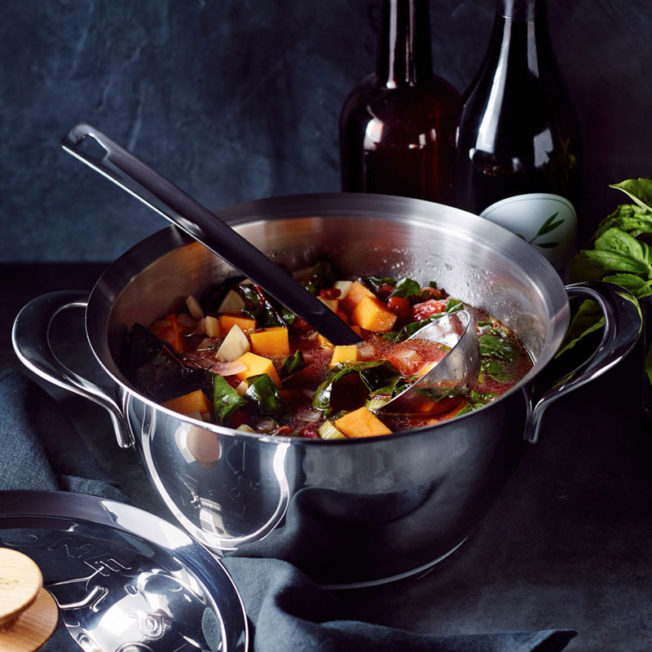
The best versions of this soup are made with fresh seasonal vegetables. Don’t hesitate to add or substitute cabbage, green beans, eggplant, cauliflower, peas, zucchini, leeks or whatever else looks good at the market. A dollop of pesto on top adds a great aroma and fresh flavor to this hearty soup. Simmering the rind from a wedge of Parmigiano-Reggiano in the soup imparts a rich, deep flavor.
Minestrone with Pesto
For the pesto:
1 1/2 cups (1 1/2 oz./45 g) lightly packed fresh basil leaves
3 Tbs. pine nuts
1 garlic clove, coarsely chopped
Kosher salt
1/3 cup (3 fl. oz./80 ml) extra-virgin olive oil
1/4 lb. (125 g) Parmigiano-Reggiano cheese, grated
For the minestrone:
1 oz. (30 g) dried porcini mushrooms
2 cups (16 fl. oz./500 ml) warm water
1/4 (2 fl. oz./60 ml) cup olive oil
1 yellow onion, chopped
2 carrots, chopped
1 celery stalk, chopped
1 bunch Swiss chard, tough stems removed and leaves chopped
3 Yukon Gold or other boiling potatoes, peeled and chopped
1 1/2 (8 oz./250 g) cups peeled, seeded and diced butternut squash
4 fresh tomatoes, peeled, seeded and chopped, or 2 cups seeded and chopped canned plum tomatoes with juices
2 cups (12 oz./375 g) fresh borlotti or other shelling beans
1 small piece Parmigiano-Reggiano cheese rind (optional)
Kosher salt and freshly ground pepper
1 cup macaroni or other small pasta shape
Grated Parmigiano-Reggiano cheese for serving
To make the pesto, in a large mortar, combine the basil, pine nuts, garlic and 1/2 tsp. salt. Using a pestle, and working in a circular motion, grind the ingredients together until a dense, thick green paste forms. This can take several minutes. Slowly drizzle in the olive oil while stirring continuously with the pestle until a thick, flowing sauce forms. Transfer to a bowl and stir in the cheese. Adjust the seasoning with salt.
Alternatively, in a food processor or blender, combine the basil, pine nuts, garlic and 1/2 tsp. salt and process until finely chopped. Then, with the motor running, pour in the olive oil in a slow, steady stream and process until a smooth, flowing sauce forms. Transfer to a bowl and stir in the cheese. Adjust the
seasoning with salt.
Use immediately, or refrigerate in an airtight container for up to 2 days or freeze for up to 2 months. Makes about 1 cup (8 oz./250 ml). You will need 1/4 (2 oz./60 g) cup for this recipe; reserve the rest for
another use.
To make the minestrone, in a bowl, combine the mushrooms and warm water and let soak for 30 minutes. Drain the mushrooms, reserving the liquid. Strain the liquid through a paper coffee filter or a fine-mesh sieve lined with dampened cheesecloth and set aside. Rinse the mushrooms well under cold running water. Drain well, chop and set aside.
In a large saucepan over medium heat, warm the olive oil. Add the onion, carrots and celery and cook, stirring frequently, until tender and golden, 10 to 15 minutes. Stir in the mushrooms, chard, potatoes, squash, tomatoes, beans and cheese rind. Add the mushroom liquid and enough water to cover the
vegetables by about 1/2 inch (12 mm), bring to a simmer and reduce the heat to low. Season with salt and pepper and cook uncovered, stirring occasionally, until the soup has thickened and the vegetables are
tender, about 1 hour, adding water as needed if the soup becomes too thick.
Add the pasta and continue to cook, stirring frequently, until the pasta is al dente, about 15 minutes. If a cheese rind has been used, you can remove it from the pot, cut it into small pieces and return it to the soup or discard it.
Ladle the soup into warmed soup bowls and top each serving with a dollop of the pesto. Serve
immediately, passing the grated Parmesan at the table. Serves 6.
Adapted from Williams-Sonoma Essentials of Italian, by Michele Scicolone
